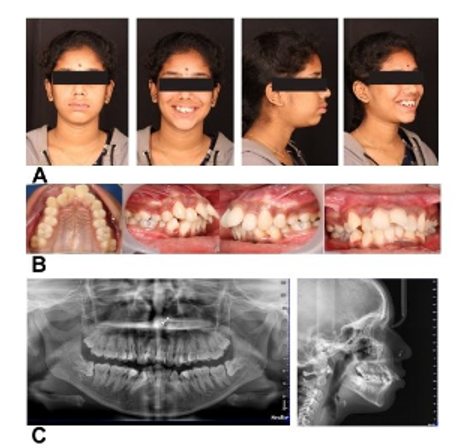Achieving Esthetics in Severe Crowding Without Extractions: A Modern Orthodontic Approach
Rajat Kanta Satapathy1 and Derine Rosalia Raj 2
1,2Post Graduate resident, Department of Orthodontics and Dentofacial Orthopaedics, Army College of Dental Sciences, Secunderabad, Telangana, India, 500087
1Orcid ID -https://orcid.org/0000-0002-6426-3876
2Orcid ID -https://orcid.org/0009-0004-2466-5813
*Corresponding author
*Rajat Kanta Satapathy, Post Graduate resident, Department of Orthodontics and Dentofacial Orthopaedics, Army College of Dental Sciences, Secunderabad, Telangana, India, 500087
Figure 1: A: Pretreatment Extraoral photographs; B: Pretreatment Intraoral photographs; C: Pretreatment Radiographs.
Figure 2: Treatment progress in 4 months.
Figure 3: Treatment results in 6 months.
- Kettle J, Warren L. Capturing the smile: Exploring embodied and social acts of smiling. Sociol Health Illn. 2024 .
- Saini R, Thakur N, Goyal RJ, Rai KS, Bagde H, Dhopte A. Analysis of Smile Aesthetic Changes With Fixed Orthodontic Treatment. Cureus. 2022 Dec;14(12).
- Jabbar A, Hussain G, Shereen S, Tariq J, Islam F, Mushtaq M. Perception of Smile Esthetics by Patients Reporting for Orthodontic Treatment. Int J Health Sci. 2022;6(S8):6851-66.
- Ackerman MB, Ackerman JL. Smile analysis and design in the digital era. J Clin Orthod. 2002 Apr 1;36(4):221-36.
- Machado AW. Mechanics to enhance facial and smile esthetics. Semin Orthod. 2020;26(3): 117-125.
- Pitts TR. Bracket positioning for smile arc protection. J Clin Orthod. 2017 Mar;51(3):142-56.
- Evrard A, Tepedino M, Cattaneo PM, Cornelis MA. Which factors influence orthodontists in their decision to extract? A questionnaire survey. J Clin Exp Dent. 2019;11(5):e432-8
- Cheng HC, Wang YC. Effect of nonextraction and extraction orthodontic treatments on smile esthetics for different malocclusions. Am J Orthod Dentofac Orthop. 2018 Jan 1;153(1):81-6.
- Arrubla-Escobar D, Barbosa-Liz DM, Zapata-Noreña O, Carvajal-Flórez A, Correa-Mullet K, Gómez-Gómez SL, Ardila CM. Smile Aesthetics Assessment in Patients Undergoing the Finishing Phase of Orthodontic Treatment: An Observational Cross-Sectional Study. Cureus. 2023 Sep;15(9).
- Seixas MR, Câmara CA. The smile arc: review and synthesis. Dent Press J Orthod. 2021 Jun 30;26:e21spe3.
- Burstone CJ. Variable-modulus orthodontics. Am J Orthod. 1981 Jul 1;80(1):1-6.



